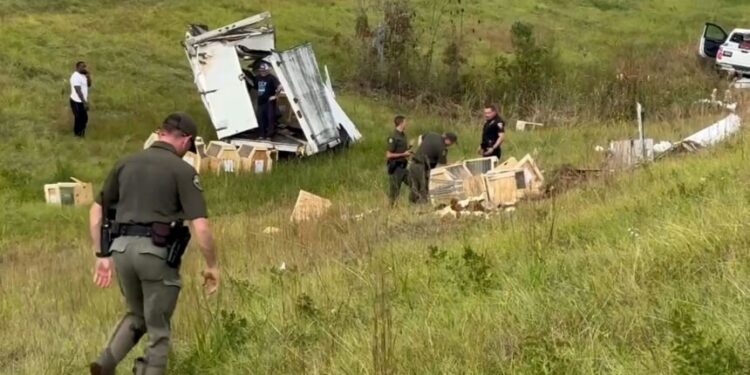Authorities in Mississippi said several monkeys “have been destroyed” but three are still on the loose after a truck carrying the animals crashed on Tuesday.
In a Facebook post, the Jasper County Sheriff’s Department previously said the rhesus monkeys carried Hepatitis C, herpes and COVID and were deemed to be “aggressive to humans,” requiring personal protective equipment to handle them.
The sheriff’s office later clarified the comments with a statement from Tulane University that the monkeys were not infected.
Deputies said the truck carrying the animals crashed on Interstate 59 near mile marker 117.
They have been in contact with an animal disposal company to find the remaining monkeys who escaped.
“Non-human primates at the Tulane National Biomedical Research Center are provided to other research organizations to advance scientific discovery,” the university said in a statement. “The primates in question belong to another entity, and they have not been exposed to any infectious agent.”
“The non-human primates were NOT being transported by Tulane, but we are actively collaborating with local authorities and are sending a team of animal care experts to assist,” the statement added.
Tulane University has been notified and will send a team to collect the remaining monkeys that are still in cages.
The Jasper County Sheriff’s Office clarified that three monkeys are on the loose, correcting earlier reports stating only one remained missing.
The “have been destroyed” phrasing indicates authorities euthanized multiple escaped monkeys that were captured rather than returning them to cages, suggesting either injury severity from the crash or determination that recapture risks to personnel outweighed the animals’ research value.
The initial Facebook post claiming rhesus monkeys carried Hepatitis C, herpes, and COVID created public panic that the subsequent Tulane University correction could not fully reverse, with misinformation spreading faster than factual clarifications in social media age.
The “aggressive to humans” characterization and personal protective equipment requirement reflects rhesus macaques’ natural behavior where these Old World monkeys bite and scratch when threatened, creating injury and disease transmission risks even for uninfected animals.
The sheriff’s office later clarification reversing infection claims demonstrates communication breakdown where law enforcement either misunderstood the monkeys’ research status or received incorrect initial information from the transport company or crash scene personnel.
Tulane University’s statement that monkeys “have not been exposed to any infectious agent” directly contradicts the sheriff’s initial post, creating confusion about whether the correction represents truth or liability-driven damage control by the institution.
The Interstate 59 mile marker 117 crash location places the accident in southeastern Mississippi’s rural Jasper County where limited local resources for exotic animal capture require outside assistance from universities and specialized companies.
The animal disposal company involvement suggests authorities contacted commercial services specializing in wildlife removal and carcass disposal rather than relying solely on university personnel or law enforcement to capture escaped primates.
The three remaining missing monkeys create ongoing public safety concerns where rural residents encounter unfamiliar animals exhibiting unpredictable behavior, potentially leading to bites if people attempt capture or try to feed apparently distressed creatures.
The Tulane National Biomedical Research Center identification as the monkeys’ origin links the primates to major research institution conducting animal experiments, though the university’s clarification that another entity owned the animals distances Tulane from direct responsibility.
The “provided to other research organizations to advance scientific discovery” language frames animal testing positively while obscuring the invasive procedures, confinement, and eventual euthanasia that characterize primate research criticized by animal rights advocates.
The “primates in question belong to another entity” disclaimer suggests Tulane either bred and sold the monkeys or served as intermediary coordinating transport between research facilities, with the institution avoiding liability by emphasizing its non-ownership status.
The clarification that primates “were NOT being transported by Tulane” but the university will “actively collaborat[e] with local authorities” creates ambiguity about the institution’s relationship to the shipment and whether contractual obligations require assistance.
The animal care expert team deployment demonstrates Tulane’s resources for primate handling, with specialists possessing training and equipment for safely capturing and restraining research monkeys that local sheriff’s deputies lack.
The monkeys still in cages indicating that only some animals escaped suggests the truck crash damaged or opened some enclosures while others remained secure, with the collection mission focusing on undamaged cages before pursuing escaped individuals.
The changing count from one to three missing monkeys demonstrates the confusion and poor accounting that characterized the incident response, with authorities initially underestimating the number of escaped animals complicating search efforts.
The rhesus macaque species identification indicates these are the most commonly used primates in biomedical research, with their genetic similarity to humans making them valuable for disease studies while their intelligence and social complexity raise ethical concerns.
The crash cause remaining unexplained raises questions about whether driver error, mechanical failure, adverse weather, or other factors led to the accident, with investigation results potentially affecting transportation regulations for hazardous biological materials.
The public safety response dilemma where authorities must balance transparency about escaped animals with avoiding panic illustrates the challenges communicating about research animals without triggering anti-science backlash or animal rights protests.
Seattle-area connections to the incident include potential Washington state research institutions receiving primates from Tulane or similar suppliers, with the Mississippi crash highlighting vulnerabilities in the national biomedical research animal transportation network.
The Facebook information dissemination demonstrates law enforcement’s reliance on social media for emergency notifications, with the platform’s rapid spread creating both benefits for public awareness and risks when initial information proves inaccurate.







